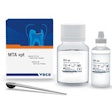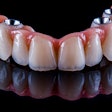Ready to elevate your suturing game? This week's clinical tip, courtesy of CDOCS, is designed to do just that.
Check out the video below from Dr. Doug Smail. You can also visit CDOCS to learn more, and learn more about CDOCS' hands-on workshops.
Video transcript
"Hi. It's Dr. Doug Smail from CDOCS, and today's tip of the day video is on simple flap elevation and comparing chromic and cytoplast sutures.
"Now, the dental form that we're going to use for the flap is the same one we use for CI-2, so you get familiar with that. And so when we're doing that again, scalpel, I've already done that right to the bone.
"You take that sharp end of the periosteal elevator, or buser, whatever you're going to use, and that goes right to the bone again. Because, really, what you're trying to do here is get started elevating that periosteum. Just sort of get it done. And you're going to just trace out your incision. When you're ready, you flip that over to the wider side, and you sort of walk it.
"You see, I'll start from one end. I'll kind of turn it, turn it, turn it, and that's walking that up and down the incision line to lift that periosteum. And you just go deeper and deeper.
So now let's take a look at those sutures. And when we're looking first at the cytoplast suture -- this is a 3-0 cytoplast suture, the same company that makes OsteoShield for DS -- and you take this suture, and as you lay it down, you'll see it has no memory, just lays flat. That's really perfect to place. And also, the suture chromic is a great suture, too, but very, very different.
"So as you see, when I pull out the 3-0 chromic out of the package, you see how it all binds up together. It's got a lot of memory, so you've got to stretch that out. So, you hold one end in your left hand and just drag it through with some tension. And it usually takes two or three times to do that.
And as you can see, it's already a little bit better. And usually, again, a couple more times, you'll see it's even better now and one more time, and it's ready to go. Because again, if it has memory, it's going to loosen up.
"So for a scalp, for the flap elevation right to the bone, trace the incision with your sharp end, walk the wider end to elevate that periosteal flap. And again, for the sutures, only chromic has the memory, so you have to stretch that out so that when you tie your knots, it doesn't come untied, but both of them can be kind of frail at the end, so if you're not careful, a little fray.
"Hope you like this video, and we'll see you at the CDOCS course. Thanks."



















